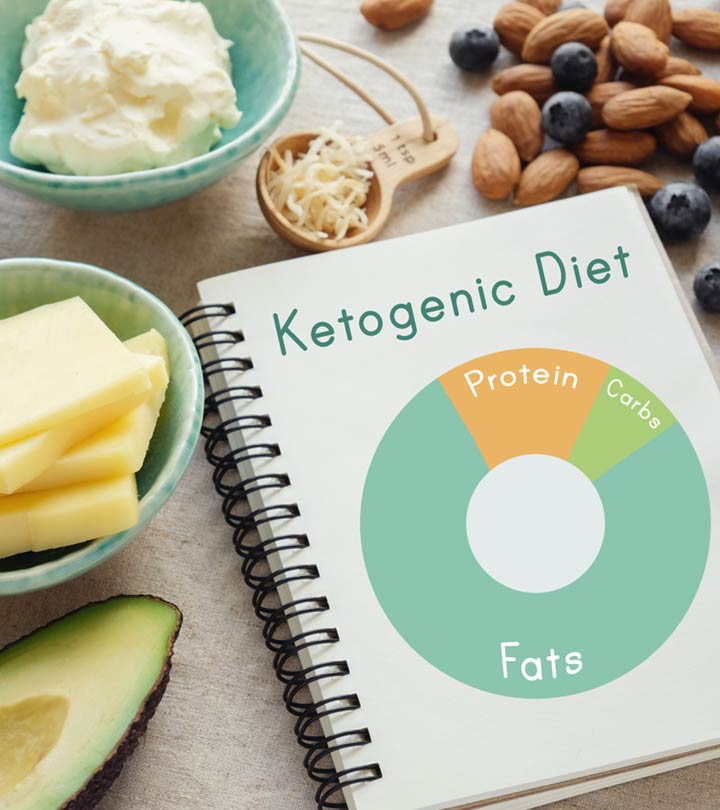Low-Oxalate Diet: Benefits, What To Eat & Avoid, And Risks
Unlock the path to better kidney health with the low-oxalate diet!

Image: Shutterstock
Foods you consume can have unexpected effects on your health. This is true especially if you are at risk of developing health issues like kidney stones. Certain foods like spinach, fish, potatoes, and oranges are nutrient-dense, but they are also high in oxalates. When it comes to dietary choices for optimizing your kidney health, a low-oxalate diet has emerged as a promising option. If you are someone who is seeking relief from kidney stones and trying to optimize your dietary habits, this article can guide you. Discover how a low-oxalate dietary approach can contribute to your overall well-being and help you take control of your health. So let’s dive into the world of low-oxalate diet and understand more about it!
 At A Glance: Low-Oxalate Diet
At A Glance: Low-Oxalate Diet- Principle: To reduce the intake of foods high in oxalates.
- Purpose: To reduce the risk of kidney stone formation and its recurrence.
- Who It Is For: Mostly for individuals at risk of or with a family history of kidney stones
- Duration: Short-term
- Who Should Avoid: People without any oxalate-related medical conditions, those with nutritional deficiencies and eating disorders
- Cons: May cause nutritional deficiencies and hamper fiber intake
In This Article
What Are Oxalates?
Oxalates are naturally occurring compounds found in vegetables, fruits, grains, and nuts (1). They are also produced as a waste product by the human body in small amounts. Oxalates are formed when oxalic acid, a substance present in leafy greens and fruits, binds with minerals like calcium (2).
These crystals have the potential to accumulate in the kidney, leading to a painful condition called Nephrolithiasisi Medical condition characterized by the formation of small, hard mineral deposits or stones in the kidney or urinary tract. (or kidney stones). These are common in people who excrete urine that contains high amounts (above 25 mg/day) of crystal-forming substances like oxalates, uric acid, and calcium (1), (3). Therefore, managing oxalate intake through dietary restrictions is essential for those who are prone to kidney stone formation.
What Is A Low-Oxalate Diet?
A low-oxalate diet is a dietary approach that limits the consumption of foods rich in oxalates, naturally occurring substances found in plant-based foods. This diet aims to lower oxalate levels in the body, especially in the urine, to lessen the chance of kidney stone development and also ease symptoms brought on by disorders such as hyperoxaluriai A medical condition caused by disordered oxalate metabolism, leading to elevated oxalate levels in urine and kidney stone formation. (1).
Doctors often recommend moderate consumption of calcium and a low intake of oxalate to prevent the formation of calcium oxalate stones (4). Generally, a low-oxalate diet is meant to limit the oxalate intake between 40- 50mg per day (5). Apart from that, staying hydrated and limiting protein intake are also two other important aspects one needs to follow when trying to adhere to this diet. It may take 3-6 weeks of following this diet to see an improvement in symptoms. However, the duration may vary depending on the severity of the condition.
Now that we know exactly what a low-oxalate diet is, it’s important to understand the benefits of a low-oxalate diet. Keep reading!
Benefits Of A Low-Oxalate Diet
A low-oxalate diet offers several potential health benefits:
1. May Reduce Urine Oxalate Levels
One major reason to follow a low-oxalate diet is to prevent kidney stones. High oxalate levels can lead to the formation of painful calcium oxalate crystals in the kidneys. Studies show that reducing oxalate intake in your diet can lower oxalate levels in your urine, reducing the risk of kidney stone formation (1).
 Pro Tip
Pro Tip2. Prevents Recurrence Of Kidney Stones
The risk of kidney stone recurrence is between 30-50% (as per observational studies). Therefore, other than necessary precautions, a diet adequate in calcium and low in oxalate can provide symptomatic relief and prevent the recurrence of kidney stones or nephrolithiasis (7).
3. May Improve Symptoms Associated With Autism
Studies found that children with autismi Also called autism spectrum disorder, is a complex developmental disorder that affects learning, communication, behavior, and interaction. have higher concentrations of oxalate in their bodies due to impaired renal excretion, which means that they are unable to eliminate oxalate properly from their bodies (8). No proper evidence seems to suggest that a high oxalate diet is related to autism. However, some dietary restrictions and changes towards maintaining a low-oxalate level may help manage hyperoxaluria (oxalate metabolism disorder) and other co-occurring symptoms like gastrointestinal issues in people with autism, as they often have disordered eating behavior (9).
4. May Prevent Cystic Fibrosis Complications
People with cystic fibrosisi A genetic disease where the production of thick mucus affects the lungs, digestive system, and other organs in the body. are at a greater risk of developing nephrolithiasis and hyperoxaluria, which may affect renal function. Studies have shown a higher prevalence of increased oxalate levels in the urine of people with cystic fibrosis (10), (11). Therefore, a low-oxalate diet may help manage and prevent cystic fibrosis complications.
5. May Help Treat Vulvodynia
Vulvodyniai Chronic pain condition characterized by persistent, unexplained discomfort or pain in the vulva, an external genital area of the female reproductive system. is a condition which is characterized by irritation, discomfort, and pain around the vagina. The exact cause of vulvodynia may not be clear, but some studies suggest that a diet low in oxalate can help reduce oxalate concentration in urine and help manage the pain related to vulvodynia (12).
There are many benefits of a low-oxalate diet as we discussed, so now let’s move on to understand which food items to avoid and eat on a low-oxalate diet.
Foods To Eat On A Low-Oxalate Diet
Here’s a list of foods that you can eat on a low-oxalate diet (13):
- Vegetables: Broccoli, cabbage, cauliflower, green beans, brussels sprouts, zucchini, asparagus, carrots, lettuce, mushrooms, onion, green peas, and radishes.
- Fruits: Apples, pears, bananas, grapes, cherries, peaches, pineapple, watermelon, mangoes, apricots, avocados, and plums.
- Dairy: Milk, cheese (except for Swiss), yogurt, butter, cottage cheese.
- Proteins: Eggs, poultry (chicken, turkey), fish (most types), lean cuts of beef and pork.
- Grains and Cereals: Rice (white and brown), oats, barley, and corn flour.
- Beverages: Water, herbal teas (e.g., chamomile, peppermint), and fruit juices.
- Herbs And spices: Cinnamon, cumin, and dill.
- Refined Foods: Bread, noodles, muffins, pasta, spaghetti, pancakes, waffles, cookies, ice cream, and soda crackers.
Foods To Avoid On A Low-Oxalate Diet
Here’s a list of high-oxalate foods that you should be cautious about (13), (15), (16):
- Vegetables: Spinach, swiss chard, beet, okra, sweet potatoes, parsley, leeks, yam, turnip, and kale.
- Fruits: Rhubarb, blackberries, blueberries, raspberries, strawberries, kiwi, concord grapes, lemon peel, tangerines, and oranges.
- Nuts And Seeds: Almonds, cashews, walnuts, pistachios, peanuts, sesame seeds, pumpkin seeds, and sunflower seeds.
- Grains And Cereals: Wheat bran, wheat germ, quinoa, amaranth, whole wheat products, buckwheat, brown rice, and cornmeal.
- Legumes: Soybeans, tofu, black beans, navy beans, kidney beans, and pinto beans
- Beverages: Tea (especially black tea), dark beer, tomato juice, cocoa and chocolate, milk, buttermilk, and wine.
 Pro Tip
Pro TipUnderstanding potential risks and side effects is crucial when considering a low-oxalate diet. Let’s learn more about the potential risks of this plan!
Side Effects Of A Low-Oxalate Diet
- May Lead To Nutritional Deficiencies: Restricting high-oxalate foods can potentially lead to nutritional deficiencies, especially if the diet is not carefully planned. Many high-oxalate foods like spinach are rich in important nutrients like vitamins, minerals, fiber, calcium, and iron (17). Lack of them in the diet may result in an insufficient intake of nutrients.
- Limits Food Choices: A low-oxalate diet can be restrictive and may limit food choices, which can make it challenging to maintain a balanced and varied diet. This limitation can lead to boredom and decrease overall dietary satisfaction. Also, vegetarians and vegans may find it difficult to meet the daily protein requirements, as plant-sourced proteins like beans, legumes, nuts, and tofu are high in oxalate.
- May Reduce Fiber Intake: Many high-oxalate foods like whole grains and certain fruits like oranges, strawberries, and raspberries, are also high in dietary fiber (17), (18). Reducing their intake may result in a lower fiber intake, potentially leading to digestive issues like constipation.
Apart from these, adhering to a low-oxalate diet can be socially challenging, as it requires avoiding many common foods at social gatherings, restaurants, and events. This restriction can affect one’s quality of life and social interactions.
Infographic: Benefits And Risks Of A Low-Oxalate Diet
Following a low-oxalate diet can offer many health advantages beyond its primary focus on managing oxalate-related concerns. However, it limits the intake of several foods that are high in other nutrients. As a result, it might be difficult to follow the diet after a certain point. The infographic below evaluates the pros and cons of this diet to help you get a better understanding of what to expect from its adherence. Take a look.

Illustration: StyleCraze Design Team
Conclusion
A low-oxalate diet can offer many health benefits and may help manage kidney stones and oxalate-related health conditions. People can lower or alleviate related symptoms, and potentially enhance their overall health through mindful food selection and oxalate intake tracking. However, it’s crucial to strike a balance, as overly restrictive diets may lead to nutritional deficiencies and other health concerns. Therefore, seeking guidance from a healthcare professional or registered dietitian is essential to ensure that a low-oxalate diet is personalized, sustainable, and nutritionally sound.
Frequently Asked Questions
Is the low-oxalate diet suitable for everyone?
No, a low-oxalate diet is not suitable for everyone. It is specifically for those struggling with medical conditions like kidney stones or hyperoxaluria.
Can we follow a low-oxalate diet while traveling?
Yes, it is possible to follow a Low-Oxalate Diet while traveling, but it requires some planning and flexibility. Researching restaurant menus, packing low-oxalate snacks, and communicating dietary needs to accommodations and dining establishments can help travelers while on the go.
Is the low-oxalate diet the same as a low-oxalate supplement?
No, they are not the same. The low-oxalate diet involves restricting the intake of high-oxalate foods, while a supplement typically provides calcium or other substances to bind with oxalates in the digestive tract, reducing their absorption.
Can we get enough nutrients on a low-oxalate diet?
Yes, it’s possible to get enough nutrients on a low-oxalate diet with careful planning. You need to strike a balance and may have to take supplements to minimize the risk of deficiencies. However, do not start the diet and take supplements without consulting a nutritionist or a registered dietitian.
What are some common misconceptions about the low-oxalate diet?
There are several misconceptions about the low-oxalate diet. People often think that all oxalates are harmful. In reality, some are essential for health. Another misconception is that the low-oxalate diet is for weight loss, while it is actually for managing kidney stones. People also think that while on this diet they have to exclude all high-oxalate foods. However, the truth is, that a few of them can be consumed in moderation. It’s all about striking a balance.
Key Takeaways
- Oxalates are naturally occurring compounds derived from oxalic acid that are present in vegetables, fruits, nuts, and grains.
- A low-oxalate diet limits the dietary intake of oxalate to reduce the risk of kidney stone formation.
- This diet also helps in reducing the rate of recurrence of kidney stones, and symptoms associated with vulvodynia.
- It limits the intake of high-oxalate such as spinach, rhubarb, strawberries, and wheat bran, and focuses on low-oxalate foods such as cabbage, cauliflower, apple, etc.
- Low-oxalate diets can be challenging for vegetarians and vegans to follow and can cause nutritional and fiber deficiencies.
In this insightful video, dive into the world of the low-oxalate diet and explore the science behind it, and the benefits and risks of embracing this dietary approach. Take a look.
References
Articles on StyleCraze are backed by verified information from peer-reviewed and academic research papers, reputed organizations, research institutions, and medical associations to ensure accuracy and relevance. Read our editorial policy to learn more.
- Dietary oxalate and kidney stone formation
https://www.ncbi.nlm.nih.gov/pmc/articles/PMC6459305/ - Oxalate content of foods and its effect on humans
https://pubmed.ncbi.nlm.nih.gov/24393738/ - Differential identification of urine crystals with morphologic characteristics and solubility test
https://www.ncbi.nlm.nih.gov/pmc/articles/PMC9701861/ - The Development of Kidney Stone Dietary Plans for Patient Education
https://files.eric.ed.gov/fulltext/EJ961158.pdf - The role of fluid intake in the prevention of kidney stone disease: A systematic review over the last two decades
https://www.ncbi.nlm.nih.gov/pmc/articles/PMC7731957/ - Calcium intake and urinary stone disease
https://www.ncbi.nlm.nih.gov/pmc/articles/PMC4708574/ - Nutritional management of kidney stones (Nephrolithiasis)
https://www.ncbi.nlm.nih.gov/pmc/articles/PMC4525130/ - A potential pathogenic role of oxalate in autism
https://pubmed.ncbi.nlm.nih.gov/21911305/ - Gastrointestinal symptoms and autism spectrum disorder: links and risks – a possible new overlap syndrome
https://www.ncbi.nlm.nih.gov/pmc/articles/PMC5683266/ - Oxalate and calcium excretion in cystic fibrosis
https://www.ncbi.nlm.nih.gov/pmc/articles/PMC2589049/ - Factors increasing the risk for stone formation in adult patients with cystic fibrosis
https://pubmed.ncbi.nlm.nih.gov/16595587/ - Vulvodynia: A review of the literature
https://www.ncbi.nlm.nih.gov/pmc/articles/PMC6313270/ - Eating, diet, & nutrition for kidney stones
https://www.niddk.nih.gov/health-information/urologic-diseases/kidney-stones/eating-diet-nutrition - Changes in levels of phytic acid, lectins and oxalates during soaking and cooking of Canadian pulses
https://pubmed.ncbi.nlm.nih.gov/29580532/ - Diet-induced oxalate nephropathy from excessive nut and seed consumption
https://www.ncbi.nlm.nih.gov/pmc/articles/PMC7705561/ - Tea and coffee as the main sources of oxalate in diets of patients with kidney oxalate stones
https://pubmed.ncbi.nlm.nih.gov/17711092/ - Nutritional characterization and food value addition properties of dehydrated spinach powder
https://www.ncbi.nlm.nih.gov/pmc/articles/PMC7866621/ - Characterization of berry pomace powders as dietary fiber-rich food ingredients with functional properties
https://www.ncbi.nlm.nih.gov/pmc/articles/PMC8909231/
Read full bio of Janelle Bigelman
Read full bio of Arshiya Syeda
Read full bio of Himanshi Mahajan






























